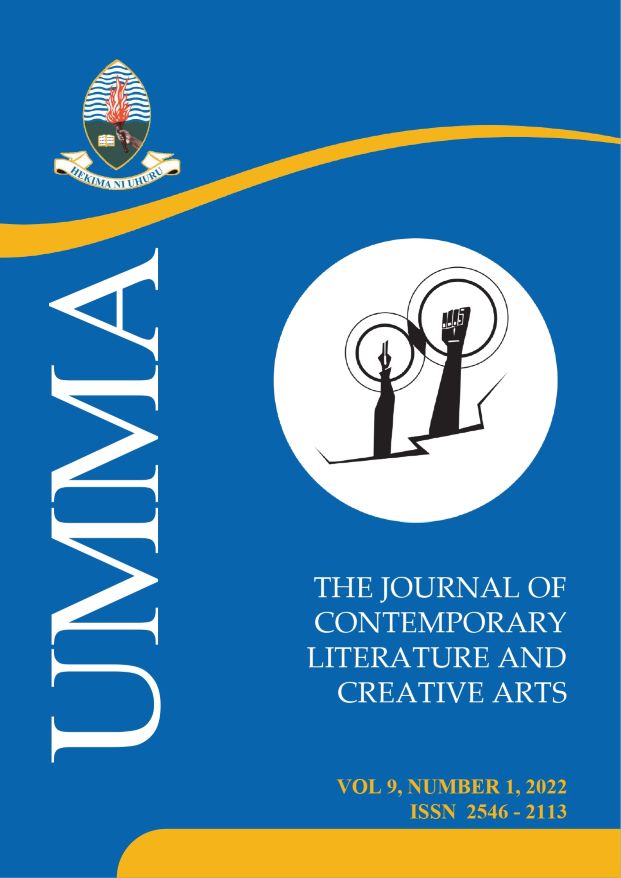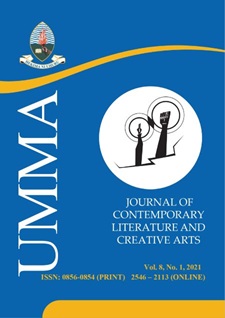12 Chiefs with the Same Face: A Formal Analysis of the Maji Maji War Heroes ' Statues
Abstract
Abstract This research addresses artistic ineptitude in historical preservation through public art. Its main objective is to argue for exceptional artistry and proper regulation of public art created for national historical preservation and promotion. Besides, this study investigates procedures followed before the creation and installation of public artwork(s) intended to preserve and promote national history in Tanzania. During the study, interviews, questionnaires, and observation methods were used to collect data. Meanwhile, the Formalism Theory informed data analysis and presentation. The findings show that all the 12 Busts installed at the Maji Maji Memorial Museum in the Songea district were ineptly designed and created. In fact, they were neither vetted by experts nor regulated before and after installation at the site. This oversight has resulted in substandard artworks, which constitute a travesty to the projection of the Maji Maji war heroes ' history while undermining the value of these busts in preserving and promoting the visual history of early anti-colonial struggles in the East African country. Moreover, these apparent artistic flaws have reduced the busts ' aesthetics value, thus generating low government, public interest, comprehension, and appreciation of the visual arts in facilitating effective conservation and promotion of national history and heritage. Thus, there is an urgent need for policymakers to consider viable and plausible artistic approaches to national history and cultural heritage conservation and promotion projects nationally and internationally in addition to enhancing local and international audiences for wider benefits.
Keywords Art, Lawrence Mtazama Gama, Maji Maji, Mashujaa, Songea, Wangoni https://dx.doi.org/10.56279/ummaj.v9i1.3
References
References
Bawazir, O. 1980, UHURU (Gazeti, 7 Julai 1980), "Uzinduzi wa
Makumbusho ya Maji" €¦pg.1, Dar es Salaam, Mpigachapa wa Serikali
Beaumont, S. 2018, Photographic and prophetic truth: Daguerreotypes, the
Holy Land, and the Bible According to Reverend Alexander Keith, in
History of Photography, vol. 42, no. 4
https://www.tandfonline.com/doi/full/10.1080/03087298.2018.1514768
on February 13, 2022, at UDSM New Library.
Editor 2019. Alichokisema Dkt. Kigwangalla Kuhusu Sanamu ya Nyerere",
Mwananchi Newspaper, Wednesday, July 10, Dar es Salaam, Mwananchi
Publications.
Enock, D. 2011, The stylistic evolution of modern Makonde sculpture in
Tanzania, University of Dar es Salaam, Dar es Salaam
Fagg, B. 1990, Nok Terracottas, Ethnographica Ltd., London and the
National Commission for Museums & Monuments, Nigeria.
Fülleborn, F. 1906, Das deutsche Njassa- und Ruwuma-gebiet, land und
leute, nebst bemerkungen über die Schire-Länder. : Mit benutzung von
ergebnissen der Njassa- und Kingagebirgs-expedition der Hermann und
Elise geb, Heckmann Wentzel-Stiftung, Berlin.
Fried, M. 2001, Roger Fry ' s formalism Roger, The Tanner Lectures on
Human Values, University of Michigan, November 2 and 3,
Fry, R. (1925) Mr. Frank Dobson's sculpture, the Burlington magazine for
connoisseurs, vol. 46, no. 265, pp. 170-173+176-177, (PUB) Burlington
Magazine Publications Ltd.
Gwassa, G.C.K. (1969) ' African Methods of Warfare during Maji Maji War
€“1907 ' , Social Science Council of the University of East Africa 1: 256 €“
Gwassa, G.C.K. 1969, German intervention and African resistance in
Tanzania, in Kimambo and A.J. Temu (eds.), A history of Tanzania, East
African Publishing House, Nairobi.
Hodd, M. 2002, East Africa handbook, footprint fravels Guides, McGraw-Hill,
New York.
Hussein, E. 1969, Kinjeketile, Oxford University Press, Nairobi.
Kirey, R.E. 2021, Decolonizing German colonial sites in Dar es Salaam: Tthe
case of Hermann von Wissmann and the Askari Monument,
Zeitgeschischte Online. Retrieved from: https://zeitgeschichteonline.de/geschichtskultur/decolonizing-german-colonial-sites-dar-essalaam, on 26th April 2022
Le Gall, Y. and Mboro, M.S. 2019, Remembering the dismembered African
human remains and memory cultures in and after repatriation. PhD. Thesis:
https://doi.org/10.25932/publishup-50850, University of Potsdam,
Germany.
Lentz, C. 2017, Ghanaian monument wars, cahiers d'études Africaines, Vol.
, Cahier 227 (3), Renouveau monumental, pp. 551-582, EHESS. Retrieved
from: https://www.jstor.org/stable/10.2307/26613054, on 15 April, 2022
at the New Library, UDSM
Lwoga, N.B. 2013, Tourism development in Tanzania before and after
independence: sustainability perspectives, Eastern African Journal of
Hospitality, Leisure and Tourism, vol. 1 no. 2. Retrieved from:
https://www.researchgate.net/publication/280254793_Tourism_Develop
ment_in_Tanzania_Before_and_After_Independence_Sustainability_Persp
ectives, on 3rd December 2021 at SJMC/UDSM, Tanzania
Makukula, D.Z. 2019, The development of visual arts in Tanzania from
to 2015: A focus on the national cultural policy and institutions
Dominicus Zimanimoto Makukula
UMMA, Volume 9 (1), 2022
influences, Ph.D. Thesis. http://dx.doi.org/10.17169/refubium-4095 Freie
Universität Berlin, Germany.
Miller, J.D. 1975, Art in East Africa: A guide to contemporary art, Frederick
Muller Ltd, >London.
Mapunda, M.A. 2006, Management plan of Maji Maji memorial museumSongea, a dissertation for Diploma in Heritage Management and Tour
Guide, University of Dar es Salaam, Department of Archaeology and
Heritage Studies, Dar es Salaam.
Matj, L. 2013, Mandela statue unveiled to celebrate the day of reconciliation,
Tshwane Update, p. 1, December edition.
Milano 2015, Media statement: the Nelson Mandela statue inaugurated City
of Milan and South African government together to celebrate the
Diplomacy of Ubuntu, Press Release retrieved from:
http://www.dirco.gov.za/milan_italy/newsandevents/mandelainaugur
ation.pdf on 6th December 2021 at SJMC/UDSM in Tanzania
Nickel, L. 2013, The first emperor and sculpture in China, Bulletin of SOAS,
vol. 76, no. 3, pp. 413-447, School of Oriental and African Studies, University
of London.
Pruitt, J. 2013, INSPIRED: three decades of Tanzanian art 1972-1993, Vijana
Vipaji Foundation, Dar es Salaam.
Rushohora, N. and Kurmann, E. 2018, Look at Maji Maji! A plea for
historical photographs in Tanzania, African Studies, vol. 77, no. 1, pp. 87-104.
A copy was supplied to the researcher by the authors on October 2021
Senie, H. and Webster, S. 1989, Critical issues in public art, Art Journal, Vol.
, no. 4, pp. 287-290, CAA with jstor, retrieved from:
https://www.jstor.org/stable/777010 on 14 April 2022 at New Library,
UDSM
Soetan, S.O., and Osadola, O. 2018, Historic preservation: prospects and
challenges, International Journal of Research and Innovation in Social Science
(IJRISS), vol. II, no. V., pp.53-56 Retrieved from:
https://www.rsisinternational.org/journals/ijriss/DigitalLibrary/volume-2-issue-5/53-56.pdf
Suh, Y. 2013, Past looking: Using arts as historical evidence in teaching
history, Social Studies Research, and Practice, vol. 8 no. 1. Retrieved from:
https://www.socstrpr.org/wp-content/uploads/2013/09/MS_06372_Spring2013.pdf on 6th December
at the SJMC/UDSM Tanzania
Upcott, L.E. 1899, Introduction to Greek sculpture, University of Oxford,
Henry Frawde, M.A.
URT 2007, Taarifa ya Ukaguzi wa Minara na Sanamu Mkoani Mwanza,
Shinyanga, Mara, Zanzibar na Pemba, Ukur. 1-15 Maktaba, Wizara ya
Utumishi wa Umma, Dar es Salaam
URT 2009, The handing-over document of the Maji Maji museum and
memorandum of understanding between the National Museum of
Tanzania, Regional Administration and the Ruvuma Elder ' s Council on 8th December.
Downloads
Published
Issue
Section
License
- Authors retain copyright and grant the journal right of first publication with the work simultaneously licensed under a Creative Commons Attribution License that allows others to share the work with an acknowledgement of the work's authorship and initial publication in this journal.
- Authors are able to enter into separate, additional contractual arrangements for the non-exclusive distribution of the journal's published version of the work (e.g., post it to an institutional repository or publish it in a book), with an acknowledgement of its initial publication in this journal.
- Authors are permitted and encouraged to post their work online (e.g., in institutional repositories or on their website) prior to and during the submission process, as it can lead to productive exchanges, as well as earlier and greater citation of published work (See The Effect of Open Access).



